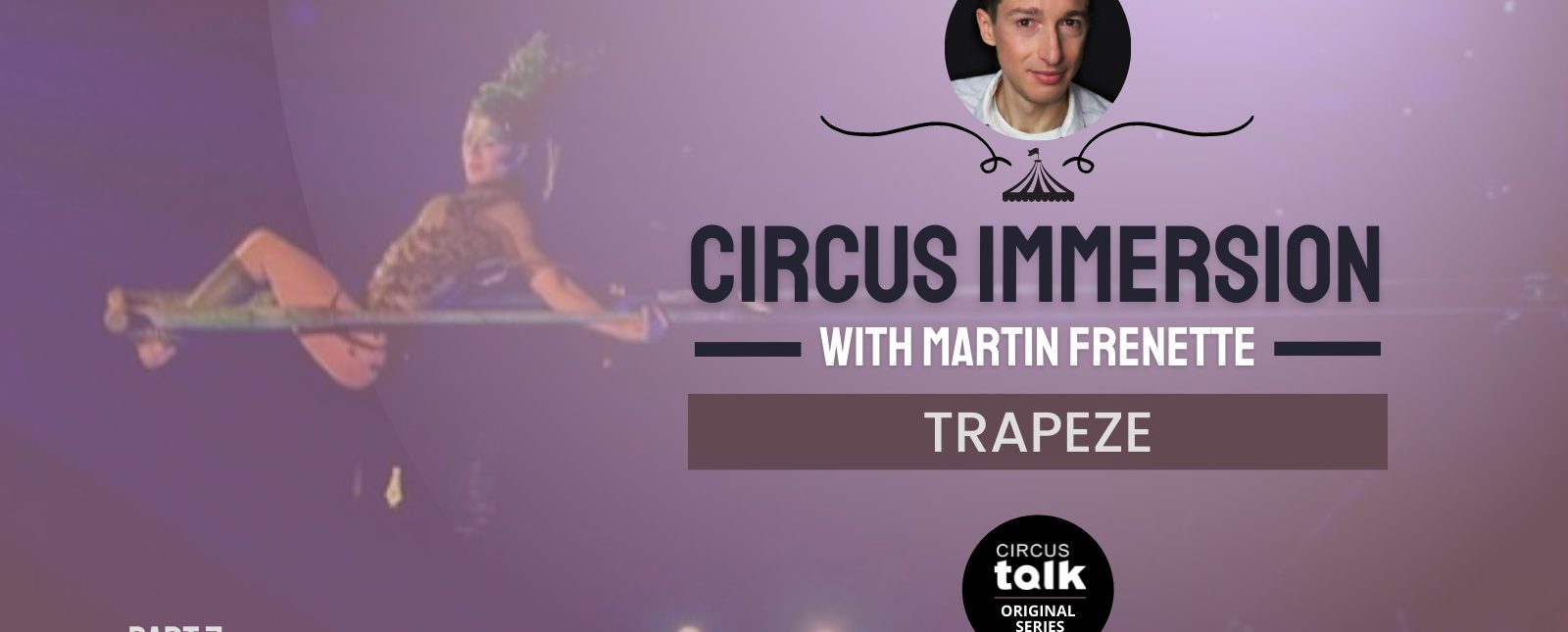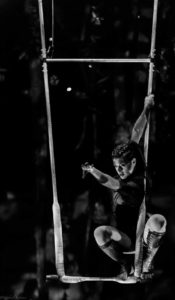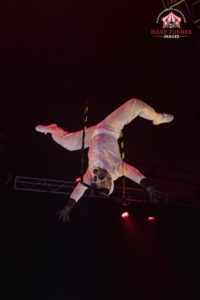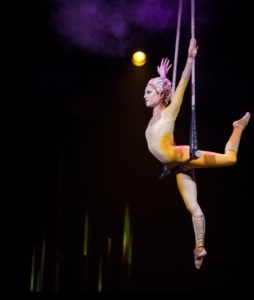Circus Immersion – Two Ropes, an Iron Bar, and Many Variations-Pro Exclusive

There’s the red nose, the lion’s mane, the fan used to cross a high wire, a bagful of popcorn. Those are the first images that come to mind when people think of the circus. Those, as well as an iron bar and two ropes hanging from the cupola. A minority of the world’s population earns a living flying through the air but each of us can relate to the joy and freedom it brings to an aerialist. We’ve all tried getting as high as we could on the playground’s swing. No one ever achieved a double twist or a salto mortale above the sandbox, but the excitement of reaching that highest point and floating in mid-air has gone through everyone’s spine. The swing being as universal an image as the trapeze might explain this act being a crowd-pleaser for decades. Initially developed under its flying form by French acrobat Jules Léotard in the 1800s, the apparatus has gone through several alterations over the years. No other discipline bears as many names as this one: static, swinging, flying, dance, triple, Washington…to name a few!

While many trapeze artists have made jumping from bar to bar a full-time career, one redefined what that meant by linking both bars and standing tall between them. Stephanie Gasparoli co-created the “Duplex” with her coach and riggers at Montreal’s National Circus School (ENC) in the 90s. “I was drawn to the trapeze the moment I set eyes on it in my hometown’s youth circus. I had the best of times up there, but also felt the need to explore new avenues, be different. This solid structure has allowed me to develop a vocabulary of vertical tricks, to go up and down rather than sticking to front and back. I feel less restricted artistically and the movement possibilities are endless,” explains Gasparoli.
Her preference for the Duplex doesn’t stop her from remaining a trapeze artist at heart. Having spent five years creating her own sequences and mastering the more traditional ones, she also toured with a regular swinging trapeze. If one is properly trained and has good technique, a double twist remains a double twist. “It just can’t be done as high as on my Duplex where 180 degrees is not the limit,” she adds with an audible wink.
Most trapeze artists agree that their static work is where they get to really express themselves. Static trapeze does not come with any rules and can convey a “pas de deux” vibe between the artist and their apparatus. Some perform a very slow dance, others go for as many drops as the music allows, and there are those who make it a point to explore every dimension and every texture a trapeze has to offer. Unlike swinging trapeze that has standards and tricks expected by producers and spectators, static trapeze is a blank canvas with more room for individuality. Such choreography brings many back home, to the place where their passions first ignited. By spending countless hours exploring and getting to know this aerial partner, one develops a strong, stable grip, and a better understanding of how the two can move together as one. Such exploration can go really deep and turn into a very personal quest, which is why there are no identical static trapeze acts.
As Gasparoli points out, trapeze training is the best aerial foundation one can get, regardless of the apparatus they’ll ultimately choose. “Every limb is involved and every muscle has its purpose. You develop such a strong grip, there is nothing like it! I got an even stronger one on my Duplex since it doesn’t have traditional ropes,” adds the 45-year-old.

Static trapeze is the base, where one goes after the playground’s swing has lost its appeal. The transition to swinging trapeze and its far different reality can occur once confidence and strength have grown. Knowing the beast inside out prepares one to take it out for a swing. By performing tricks higher, at the very front or very back of the circus tent, and without a net, “swingers” are exposed to greater risks. It is more challenging, requires a higher focus, and feels more like an athletic performance than an artistic one. Tricks must become normal, almost second nature, like in most circus disciplines. Getting every movement to look as fluid and smooth as possible without getting in an auto-pilot mode is the goal. One can’t forget the discipline’s danger factor and that very precise moment to arch back in a tempo.
“Being so high and far from the audience makes it hard to connect with them and avoid the auto-pilot. There often only is that brief moment between two pushes or recovering from a trick to really look at them, but their presence and their response can do a lot. They bring me back and make me push higher. I use my energy and the joy that swinging brings me to connect with the crowd. My body language can communicate a lot,” she concludes as one of her seven dogs starts barking in the background.
An Art That Keeps Reinventing Itself…

“Stephanie Gasparoli! Her act blew me away!” is Adam Malone‘s quickest and most honest answer when asked to pick his all-time favorite trapeze artist. Growing up doing gymnastics in New South Wales, the young Australian’s future took a turn when he attended a representation of Cirque du Soleil’sQuidam. The music and set design stuck with him and a desire to fly above the stage was born. His encounter with a dance-trapeze at Melbourne’s National Institute of Circus Arts was a determining one. “I was instantly drawn to it, to its appearance, and the infinite movement possibilities that were available to me. It felt more exciting and universal than the aerial hoop I had been training on up until then,” he says with the warmest energy linking his words.
In spite of having a strong interest in hand balancing, the young man had no desire to make it a full-time commitment. His first rise on a Washington trapeze was an acrobatic epiphany: working simultaneously on handstands and aerial movement was possible! Malone and his coach then started looking for ways to broaden their artistic possibilities and move away from the traditional act where one takes a few swings before balancing on their head and hand. “I have really high energy and wanted to give a contemporary flair to what felt like a one-dimensional act. My coach and I picked a trapeze 24 kilos lighter than the usual one and united the ropes to make it a one-point trapeze. Those changes made spinning, circling, and more dynamic balancing tricks possible,” he explains.
There is something very simple yet quite intricate in the way the aerialist balances on his head and twirls rings with his feet. Besides being one of circus’ roots and oldest disciplines, trapeze best represents the art form with the two emotions it conveys: simplicity and intricacy. An act can be narrowed down to dropping and catching the same way that movement and emotion can sum up a circus show. However, both have layers upon layers that make them so much more.

A juggling ball has one smooth surface, fabric hanging from a carabiner feels like a continuous embrace, while a trapeze offers different textures and sensations. One doesn’t hold to the ropes the way they do on the bar and they can’t wrap their legs as easily around the latter. There is as much research to be done on it as there is around it. The most impassioned swinging trapeze artists are still working on delivering more than “push, push, a trick, a little move, push, push, push, another trick, and another push.” In fact, trapeze is an art that keeps reinventing itself. The way some have rethought it by rigging it differently, performing with another artist on it, or adding balancing elements to its existing vocabulary proves it well.
Echoing Gasparoli’s train of thought, Malone agrees that trapeze artists don’t connect with the crowd as others do on the ground. The 29-year-old sees the audience as his guide or an artistic compass.“It’s a give-and-take relationship. I can’t see them, but I’m listening to them. I can feel their reaction and hear which movement really got to them. This space between us is an ongoing connection and listening to them as I fly and spin keeps me going,” concludes Malone.
More Than a Prop, an Extension of the Limb
Whether one balances on their head, swings high or hangs by their knees, the trapeze’s structure is somewhat always the same. It is something to play with, to hold on to, and push off. More than a prop, the trapeze is a partner and each makes artists move differently. Having gone from static, to swinging, and then to triple with five partners before finding her place on a dance-trapeze, Kerren McKeeman can attest to that and to how each has influenced the artist she grew up to be.
One must know where the center is at all times and adapt their vocabulary to the spinning motion.
“Trapeze is a set structure, but the ropes are malleable. It can change shape and provide a solid base. I’ve always liked to create within a structure and push its limits, which is precisely what trapeze is. That was the common thread that stayed with me from one trapeze act to the next,” explains McKeeman as if talking about a close friend.

A college graduate in Eastern Asian languages who had spent her childhood and teens training in the air, she turned down a Chinese TV station’s job offer to join Cirque du Soleil‘sO and never looked back. Her strong grip and deep interest in movement research led to the creation of several acts until dance-trapeze stood out as the one where she had to truly invest. Wanting to look as graceful as she was powerful and to literally fly above audiences, McKeeman dug into years of static work and integrated and rediscovered it through flights and spins. The joy that fills her voice when describing the freedom that flying brings her is contagious and instantly connects her to Gasparoli and Malone.
If hours spent on a bar hanging from two points are a great foundation and perhaps a necessary place to start, a trapeze artist’s body of work goes through significant changes when transitioning to a single point. Each movement had to come from their body and equally distribute their weight between the two ropes to avoid an unwanted shift from the bar. Once both ropes are sharing the same carabiner, it is all about that single point. One must know where the center is at all times and adapt their vocabulary to the spinning motion. Whereas the aerialist once used to guide and move the trapeze from one position to the next, they must somewhat relinquish the power and let the trapeze be the one that guides and grounds them. “It becomes an extension of my arm and reacts to every little move that I do when the two of us are in perfect symbiosis,” shares the 36-year-old.
The ability to create such symbiosis with a partner serves her as the half of an aerial straps duo in another Cirque du Soleil production. She describes this connection with a human partner as one where they share the same brain and feels that years of listening to and feeling her trapeze subconsciously prepared her for such a duo.

As for her rapport with those on the ground, McKeeman states that everything is a choice and that each aerialist can make the right ones to connect with a crowd: a look, even a quick one, deep breathing that changes their lines, or a simple move that only a few might catch. “If an artist feels something strong and genuine, the audience will get it. I felt best acknowledging and allowing every emotion that was going through my mind and body on any given day, in order to convey them truly and fully in the act,” she concludes before heading out to do a show.
These three artists are from different countries, belong to different generations, and practice three different types of trapeze, and yet, they share the same connection: the joy and freedom of flying in an environment that is both rigid and malleable. Each praises the endless movement possibilities that it offers and that none experienced with any other discipline. Lastly, as Mckeemann pointed out, let’s not forget that the leotard, that one piece of clothing that every artist wore at least once, was created by a certain trapeze artist who gave it his name. Remember him?
Editor's Note: At StageLync, an international platform for the performing arts, we celebrate the diversity of our writers' backgrounds. We recognize and support their choice to use either American or British English in their articles, respecting their individual preferences and origins. This policy allows us to embrace a wide range of linguistic expressions, enriching our content and reflecting the global nature of our community.
🎧 Join us on the StageLync Podcast for inspiring stories from the world of performing arts! Tune in to hear from the creative minds who bring magic to life, both onstage and behind the scenes. 🎙️ 👉 Listen now!
